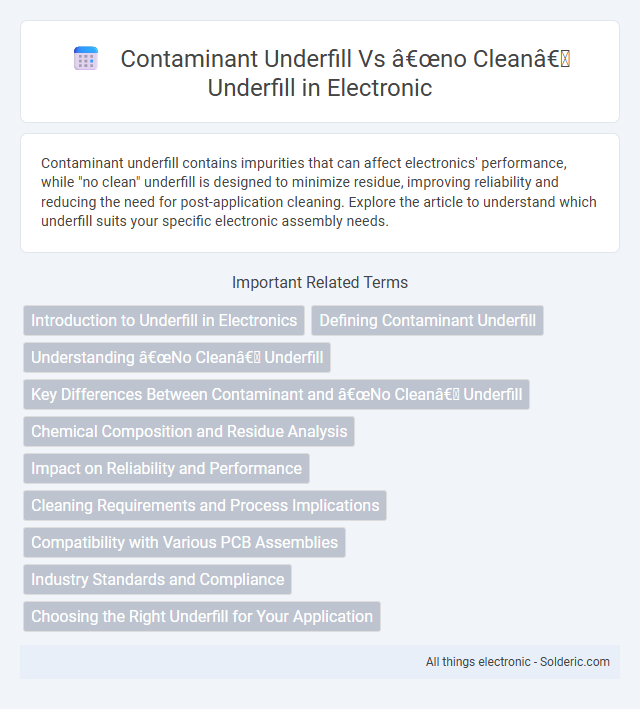Contaminant underfill contains impurities that can affect electronics' performance, while "no clean" underfill is designed to minimize residue, improving reliability and reducing the need for post-application cleaning. Explore the article to understand which underfill suits your specific electronic assembly needs.
Comparison Table
| Feature | Contaminant Underfill | No Clean Underfill |
|---|---|---|
| Definition | Underfill containing residues or contaminants that may require cleaning. | Underfill designed to leave minimal or no residues, eliminating cleaning steps. |
| Cleaning Requirement | Requires post-application cleaning to remove contaminants and ensure reliability. | No cleaning needed due to residue-free or benign residues formulation. |
| Reliability | May risk long-term reliability if contaminants remain after underfill curing. | Higher reliability as minimal residues reduce risk of corrosion and failure. |
| Process Complexity | Additional cleaning step increases process time and cost. | Simplifies process, reducing time and manufacturing costs. |
| Application Areas | Used where specific underfill properties outweigh cleaning concerns. | Preferred in high-volume and sensitive electronic assemblies. |
| Environmental Impact | Cleaning solvents may contribute to environmental and safety concerns. | Eco-friendlier due to elimination of solvent-based cleaning. |
| Cost Impact | Higher overall cost due to cleaning and handling of residues. | Lower total cost from streamlined process and reduced materials. |
Introduction to Underfill in Electronics
Underfill in electronics is a critical process used to enhance the mechanical strength and reliability of solder joints in semiconductor devices by filling the gap between the chip and substrate. Contaminant underfill contains specific additives to improve adhesion and protect against environmental factors, while "no clean" underfill eliminates the need for residue cleaning, simplifying manufacturing and reducing potential damage to components. Understanding these differences helps optimize your device's durability and manufacturing efficiency in high-performance electronic assemblies.
Defining Contaminant Underfill
Contaminant underfill refers to an encapsulant material applied beneath electronic components to enhance mechanical strength while containing impurities that may cause corrosion or electrical failures. This type of underfill typically involves flux residues and other contaminants trapped during the process, posing reliability risks in sensitive assemblies. In contrast, "no clean" underfill is formulated to minimize or eliminate such residues, promoting improved long-term performance and reducing the need for additional cleaning steps.
Understanding “No Clean” Underfill
"No Clean" underfill eliminates the need for post-encapsulation cleaning by using specialized resins that leave minimal residues, preventing contamination and corrosion risks common with traditional contaminant underfill. This type of underfill maintains high reliability in electronic assemblies by ensuring strong adhesion and protection against thermal and mechanical stress without requiring solvent cleaning processes. Understanding "No Clean" underfill is crucial for optimizing manufacturing efficiency, reducing environmental impact, and enhancing long-term device performance.
Key Differences Between Contaminant and “No Clean” Underfill
Contaminant underfill contains residues that may require cleaning after application to avoid reliability issues, while "no clean" underfill is designed to leave minimal, non-corrosive residues that do not necessitate post-curing cleaning. The key differences between contaminant and "no clean" underfill include their residue composition, impact on circuit board reliability, and the need for additional cleaning processes. Choosing the right underfill type influences your manufacturing efficiency and long-term device performance.
Chemical Composition and Residue Analysis
Contaminant underfill contains fillers or additives that can interact chemically during curing, leading to residues with potential ionic contamination detectable by ion chromatography and surface insulation resistance tests. "No clean" underfill formulations use low-residue, non-corrosive chemistries designed to minimize ionic and organic residues, avoiding the need for post-application cleaning. Your choice impacts reliability; analyzing residue content with techniques like SEM-EDS and FTIR spectroscopy ensures compatibility with your device's sensitivity requirements.
Impact on Reliability and Performance
Contaminant underfill often contains residues that can degrade electrical insulation and cause corrosion, negatively impacting the reliability and performance of electronic assemblies. In contrast, "no clean" underfill formulations leave minimal residue after curing, enhancing long-term stability and reducing the risk of circuit failure. Choosing the right underfill directly affects Your device's durability, especially in harsh environmental conditions or high-stress applications.
Cleaning Requirements and Process Implications
Contaminant underfill typically requires thorough cleaning to remove residual flux and contaminants, ensuring optimal adhesion and reliability in electronic assemblies. "No clean" underfill formulations minimize or eliminate cleaning steps by using fluxes that leave benign residues, reducing process time and costs while maintaining device performance. Selecting between these underfill types impacts the overall manufacturing workflow, influencing drying processes, inspection protocols, and long-term reliability testing.
Compatibility with Various PCB Assemblies
Contaminant underfill offers strong adhesion and excellent moisture resistance but may introduce residues incompatible with sensitive PCB components, posing risks in high-reliability assemblies. "No clean" underfill formulations are designed to leave minimal or benign residues, enhancing compatibility with diverse PCB assemblies, especially those using fine-pitch components or requiring stringent cleanliness standards. Selecting the appropriate underfill depends on balancing contamination risk with assembly complexity and long-term performance requirements.
Industry Standards and Compliance
Contaminant underfill and "no clean" underfill are evaluated under stringent industry standards such as IPC-9701 and J-STD-004 to ensure reliability and minimal residue impact on electronic assemblies. Compliance with these standards mandates thorough testing for ionic contamination, moisture resistance, and thermal cycling durability, directly influencing long-term performance in aerospace, automotive, and consumer electronics sectors. Selecting the appropriate underfill material requires adherence to specific regulatory requirements like RoHS and REACH, which govern hazardous substance limits and ensure safe handling and disposal within global manufacturing chains.
Choosing the Right Underfill for Your Application
Choosing the right underfill for your application depends on factors like contamination levels and cleaning requirements; contaminant underfill offers robust protection against particulate ingress but may require post-process cleaning, while "no clean" underfill is engineered to eliminate residue, reducing overall maintenance. You should evaluate the thermal expansion properties and compatibility with your PCB to ensure reliability and performance under operational stresses. Prioritizing the balance between protection, cleaning complexity, and cost-efficiency will help determine the optimal underfill solution for your electronics assembly.
Contaminant underfill vs “no clean” underfill Infographic

 solderic.com
solderic.com